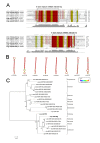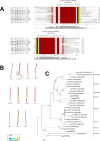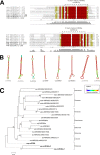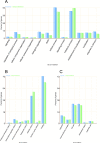A genome-wide analysis of the RNA-guided silencing pathway in coffee reveals insights into its regulatory mechanisms
- PMID: 28448529
- PMCID: PMC5407642
- DOI: 10.1371/journal.pone.0176333
A genome-wide analysis of the RNA-guided silencing pathway in coffee reveals insights into its regulatory mechanisms
Abstract
microRNAs (miRNAs) are derived from self-complementary hairpin structures, while small-interfering RNAs (siRNAs) are derived from double-stranded RNA (dsRNA) or hairpin precursors. The core mechanism of sRNA production involves DICER-like (DCL) in processing the smallRNAs (sRNAs) and ARGONAUTE (AGO) as effectors of silencing, and siRNA biogenesis also involves action of RNA-Dependent RNA Polymerase (RDR), Pol IV and Pol V in biogenesis. Several other proteins interact with the core proteins to guide sRNA biogenesis, action, and turnover. We aimed to unravel the components and functions of the RNA-guided silencing pathway in a non-model plant species of worldwide economic relevance. The sRNA-guided silencing complex members have been identified in the Coffea canephora genome, and they have been characterized at the structural, functional, and evolutionary levels by computational analyses. Eleven AGO proteins, nine DCL proteins (which include a DCL1-like protein that was not previously annotated), and eight RDR proteins were identified. Another 48 proteins implicated in smallRNA (sRNA) pathways were also identified. Furthermore, we identified 235 miRNA precursors and 317 mature miRNAs from 113 MIR families, and we characterized ccp-MIR156, ccp-MIR172, and ccp-MIR390. Target prediction and gene ontology analyses of 2239 putative targets showed that significant pathways in coffee are targeted by miRNAs. We provide evidence of the expansion of the loci related to sRNA pathways, insights into the activities of these proteins by domain and catalytic site analyses, and gene expression analysis. The number of MIR loci and their targeted pathways highlight the importance of miRNAs in coffee. We identified several roles of sRNAs in C. canephora, which offers substantial insight into better understanding the transcriptional and post-transcriptional regulation of this major crop.
Conflict of interest statement
Figures










Similar articles
-
The Complexity of Posttranscriptional Small RNA Regulatory Networks Revealed by In Silico Analysis of Gossypium arboreum L. Leaf, Flower and Boll Small Regulatory RNAs.PLoS One. 2015 Jun 12;10(6):e0127468. doi: 10.1371/journal.pone.0127468. eCollection 2015. PLoS One. 2015. PMID: 26070200 Free PMC article.
-
In Medicago truncatula, water deficit modulates the transcript accumulation of components of small RNA pathways.BMC Plant Biol. 2011 May 10;11:79. doi: 10.1186/1471-2229-11-79. BMC Plant Biol. 2011. PMID: 21569262 Free PMC article.
-
Phylogenetic analyses of seven protein families refine the evolution of small RNA pathways in green plants.Plant Physiol. 2023 May 31;192(2):1183-1203. doi: 10.1093/plphys/kiad141. Plant Physiol. 2023. PMID: 36869858 Free PMC article.
-
Plant dicer-like proteins: double-stranded RNA-cleaving enzymes for small RNA biogenesis.J Plant Res. 2017 Jan;130(1):33-44. doi: 10.1007/s10265-016-0877-1. Epub 2016 Nov 24. J Plant Res. 2017. PMID: 27885504 Review.
-
The Biosynthesis Process of Small RNA and Its Pivotal Roles in Plant Development.Int J Mol Sci. 2024 Jul 12;25(14):7680. doi: 10.3390/ijms25147680. Int J Mol Sci. 2024. PMID: 39062923 Free PMC article. Review.
Cited by
-
Comprehensive In Silico Analysis of RNA Silencing-Related Genes and Their Regulatory Elements in Wheat (Triticum aestivum L.).Biomed Res Int. 2022 Sep 19;2022:4955209. doi: 10.1155/2022/4955209. eCollection 2022. Biomed Res Int. 2022. PMID: 36177060 Free PMC article.
-
Small RNAs: Promising Molecules to Tackle Climate Change Impacts in Coffee Production.Plants (Basel). 2023 Oct 11;12(20):3531. doi: 10.3390/plants12203531. Plants (Basel). 2023. PMID: 37895993 Free PMC article. Review.
-
Genome-Wide Identification of Key Components of RNA Silencing in Two Phaseolus vulgaris Genotypes of Contrasting Origin and Their Expression Analyses in Response to Fungal Infection.Genes (Basel). 2021 Dec 27;13(1):64. doi: 10.3390/genes13010064. Genes (Basel). 2021. PMID: 35052407 Free PMC article.
-
Genome-wide identification, evolutionary relationship and expression analysis of AGO, DCL and RDR family genes in tea.Sci Rep. 2021 Apr 21;11(1):8679. doi: 10.1038/s41598-021-87991-5. Sci Rep. 2021. PMID: 33883595 Free PMC article.
-
Genome-wide analysis of AGO, DCL and RDR gene families reveals RNA-directed DNA methylation is involved in fruit abscission in Citrus sinensis.BMC Plant Biol. 2019 Sep 12;19(1):401. doi: 10.1186/s12870-019-1998-1. BMC Plant Biol. 2019. PMID: 31510935 Free PMC article.
References
-
- Brodersen P, Voinnet O. The diversity of RNA silencing pathways in plants. Trends in Genetics. 2006;22(5):268–80. doi: 10.1016/j.tig.2006.03.003 - DOI - PubMed
-
- Axtell MJ. Classification and comparison of small RNAs from plants. Annu Rev Plant Biol. 2013;64(1):137–59. - PubMed
-
- Borges F, Martienssen RA. The expanding world of small RNAs in plants. Nat Rev Mol Cell Biol. 2015;16(12):727–41. Epub 2015/11/05. PubMed Central PMCID: PMCPmc4948178. doi: 10.1038/nrm4085 - DOI - PMC - PubMed
-
- Kim YJ, Zheng B, Yu Y, Won SY, Mo B, Chen X. The role of Mediator in small and long noncoding RNA production in Arabidopsis thaliana. The EMBO journal. 2011;30(5):814–22. Epub 2011/01/22. PubMed Central PMCID: PMCPmc3049218. doi: 10.1038/emboj.2011.3 - DOI - PMC - PubMed
MeSH terms
Substances
LinkOut - more resources
Full Text Sources
Other Literature Sources

